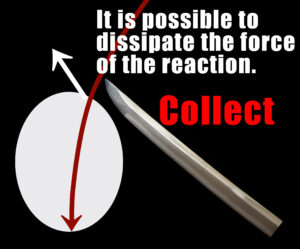拝抜 Ogaminuki – Part 2 –
Points to Note: Posture when cutting down
*Correct Posture (Shu 守・Kaisho 楷書)
Push your hips forward, pull your head back, arch your back, and tilt your upper body backward.
*Not correct
1,Keep your upper body vertical without leaning backward.
In “Ri 離” (Sosyo 草書), a similar posture is adopted.
2,The head is leaning forward.
Additional Points
Posture in the case of “Ri” (Sosyo)
The upper body remains almost vertical.
Points to Not : About the Shape of the Feet
When cutting down, bend both knees while spreadi ng them wide outward, and raise both toes as much as possible.
The coordination of leg spreading, knee bending, and ankle plantar flexion is an essential movement that forms the foundation of footwork in Tenshinryu.
In the case of “Ri,” the angles of knee bending and opening, as well as the way the toes are raised, become more relaxed.
Points to Note:
・The Sword’s Trajectory
・The Angle Between the Forearm and the Sword
Correct
When cutting down toward the face, do not twist the wrist.
After cutting the Omote (面 face/head), turn the wrist (Hizagoshi – knee level).
Not Correct
If you turn your wrist before cutting the face, the cut will not be effective.
The important factor in cutting is the angle between the blade and the target. Ideally, the contact point between the blade and the target should always slide. If the blade’s trajectory is close to a straight line, the angle to the cutting surface becomes nearly perpendicular, resulting in a pushing-type cut. In Tenshinryu, this type of cutting is called “Osaegiri” and is also used as “Kiriwake” (adjusting the cutting method according to the situation).


When cutting down, the forearm and the sword should be aligned in a straight line.
Points to Note: About the Tip of the Sword When Cutting Down
When cutting down, be mindful that the tip of the sword momentarily comes to a stop. This is simply the natural stopping of the sword, not a forced stop using arm strength. If the tip of the sword bounces when returning to Seigan, posture it is a sign of a lack of control over the sword. Immediately returning to the Seigan posture after cutting down prevents movement from becoming fixed, avoiding a “Shikitai” (死気体 dead stance) that hinders transition to the next action. This is crucial for assessing the opponent’s movements and determining the next action.
Points to Note: How to Position the Feet
When transitioning to Bajō-dachi (馬上立) after cutting down, open both feet evenly in the order of the left foot first, followed by the right foot.
*Bad Example
1,Jump and spread both feet apart.
2,Opening only one foot (or having an uneven movement distance between both feet).
Application: Kesa-gake
As you become accustomed, you will also practice Kesa-gake. The movements, such as drawing the sword, do not differ significantly, but the position of both fists when raising the sword does. When cutting down from In (right) to Yo (left), the fists should be positioned around the right temple. When cutting down from Yo (left) to In (right), the fists should be positioned around the left temple.
Conclusion
A distinctive feature of this technique is standing on the toes and adopting a bow-legged stance. It is by no means a flashy or aesthetically appealing technique. Additionally, it requires a highly demanding posture, making it one of the techniques that are often avoided. However, it encapsulates fundamental principles—from the basics of drawing the sword to the role of the legs and the mechanics of cutting down—making it an essential and valuable technique. Especially in Shu (Kaisho) training, perform each movement carefully and distinctly, dividing them clearly: Reihō (Bow), placing the hand on the hilt, drawing the sword, placing the left hand on the tsuka, swinging the sword down, and returning to Seigan. Execute each step with precision and mindfulness.


コメント